For centuries Oak has been used, and admired, as flooring. Whilst hardwood flooring can be produced from a variety of different tree species, for many a beautiful wooden floor is synonymous with Oak. Oak flooring remains an enduringly popular choice with our customers.
Here are some of the benefits and considerations for anybody thinking about having real Oak flooring installed in their property.
Attractive and versatile
An introduction to solid and engineered Oak flooring
For centuries Oak has been used, and admired, as flooring. Whilst hardwood flooring can be produced from a variety of different tree species, for many a beautiful wooden floor is synonymous with Oak. Oak flooring remains an enduringly popular choice with our customers.
Here are some of the benefits and considerations for anybody thinking about having real Oak flooring installed in their property.
Attractive and versatile
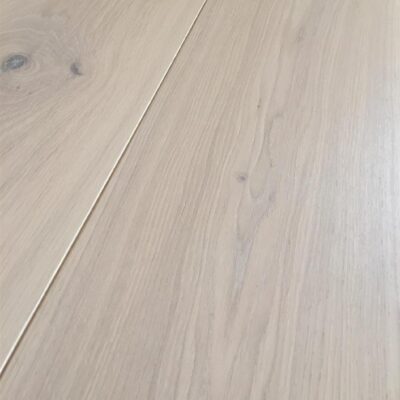
Iga White (white tinted Oak with an oil finish)
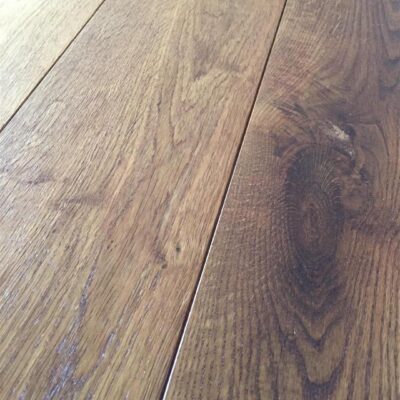
Peat (fumed Oak with hard wax oil)

Iga White (white tinted Oak with an oil finish)

Peat (fumed Oak with hard wax oil)
Whether you are envisioning a traditional or contemporary wood floor for your property, a real Oak floor is attractive, versatile and rises to any occasion.
For a fresh, natural look, Oak can be enhanced with a clear or lightly tinted protective finish. At the other end of the continuum, a rich, dramatic floor can be achieved with darker finishes and by introducing texture.
Different cuts of Oak can be used to display its beautiful figure. Quartersawn Oak enables the medullary rays to be featured, creating light streaks in the flooring (the rays are comprised of specialist cells through which sap travelled, enabling the tree to grow).
Another interesting option is Pippy Oak, with its distinctive paw like patterns of fine knots.
Whether you are envisioning a traditional or contemporary wood floor for your property, a real Oak floor is attractive, versatile and rises to any occasion.
For a fresh, natural look, Oak can be enhanced with a clear or lightly tinted protective finish. At the other end of the continuum, a rich, dramatic floor can be achieved with darker finishes and by introducing texture.
Different cuts of Oak can be used to display its beautiful figure. Quartersawn Oak enables the medullary rays to be featured, creating light streaks in the flooring (the rays are comprised of specialist cells through which sap travelled, enabling the tree to grow).
Another interesting option is Pippy Oak, with its distinctive paw like patterns of fine knots.
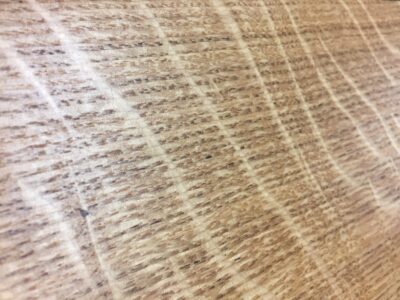
Quartersawn Oak with medullary rays
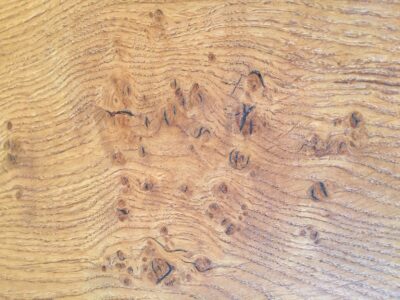
Pippy Oak

Quartersawn oak with medullary rays

Pippy Oak
It’s practical
Oak is a highly practical choice for flooring. Dense, stable, durable and hard wearing, it is receptive to finishes, ages well (often looking better over time) and is pretty forgiving. A quality Oak floor is straightforward to look after and with a little care and maintenance, should look beautiful and last a lifetime.
It’s practical
Oak is a highly practical choice for flooring. Dense, stable, durable and hard wearing, it is receptive to finishes, ages well (often looking better over time) and is pretty forgiving. A quality Oak floor is straightforward to look after and with a little care and maintenance, should look beautiful and last a lifetime.
Using tints and adding texture
Oak is very receptive to colour tinting and specialist finishes: light white tones help create a modern, minimalist look, while darker tones and finishes can be combined with special techniques to create texture and produce an aged, historic look. Methods include using steel brushes to remove the softer grain, leaving a smooth but tactile finish and antiquing, where boards can be tumbled with hard objects to create the sense of an aged floor with history.
Using tints and adding texture
Oak is very receptive to colour tinting and specialist finishes: light white tones help create a modern, minimalist look, while darker tones and finishes can be combined with special techniques to create texture and produce an aged, historic look. Methods include using steel brushes to remove the softer grain, leaving a smooth but tactile finish and antiquing, where boards can be tumbled with hard objects to create the sense of an aged floor with history.
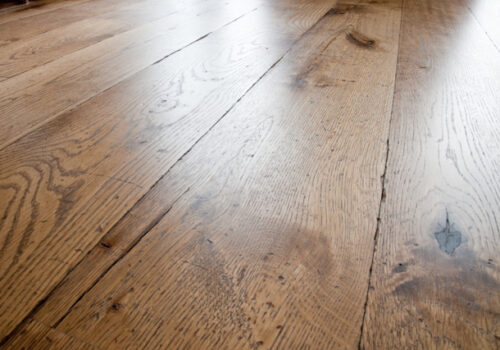
Georgian Antiqued Oak (tumbled and coloured for an aged effect)

Georgian Antiqued Oak (tumbled and coloured for an aged effect)
Our Oak products
With the exception of Walnut and Raintree, our selection of wood flooring products is comprised of Oak floorboards with different tones, tints and treatments. We offer Oak in natural, white, grey or darker finishes. Oak flooring can be prefinished or finished on site to achieve a desired look. It can be laid as boards, panels such as Versailles, and in patterns such as herringbone or chevron.
Our Oak products
With the exception of Walnut and Raintree, our selection of wood flooring products is comprised of Oak floorboards with different tones, tints and treatments. We offer Oak in natural, white, grey or darker finishes. Oak flooring can be prefinished or finished on site to achieve a desired look. It can be laid as boards, panels such as Versailles, and in patterns such as herringbone or chevron.
Floorboard widths and grades
The choice of floorboard width and grade will influence the overall appearance and impact of an Oak floor. At one end of the continuum, strip flooring (the narrowest boards) can produce a funkier look, especially when a variety of tones are used together, whilst wide board flooring can look dramatic and opulent and is often suited to larger spaces. As a general guide, we offer widths from 50mm to over 300mm wide, dependent on flooring product. We supply grades from rustic (more knots and colour variation) through to prime (virtually knot free and typically more consistent in colour). Sometimes a finish will work well with a particular grade of wood. Width and grade form part of the considerations we discuss with customers to come up with the perfect wooden floor for their installation.
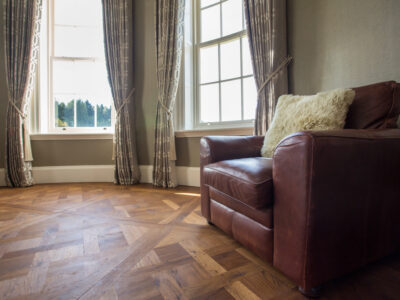
Versailles Panels
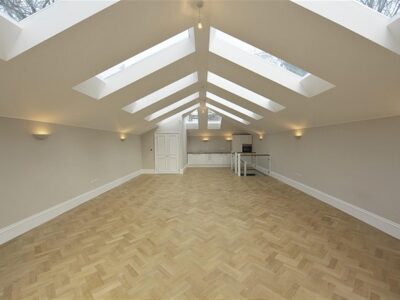
Herringbone Oak Parquet

Versailles Panels

Herringbone Oak Parquet
Floorboard widths and grades
The choice of floorboard width and grade will influence the overall appearance and impact of an Oak floor. At one end of the continuum, strip flooring (the narrowest boards) can produce a funkier look, especially when a variety of tones are used together, whilst wide board flooring can look dramatic and opulent and is often suited to larger spaces. As a general guide, we offer widths from 50mm to over 300mm wide, dependent on flooring product. We supply grades from rustic (more knots and colour variation) through to prime (virtually knot free and typically more consistent in colour). Sometimes a finish will work well with a particular grade of wood. Width and grade form part of the considerations we discuss with customers to come up with the perfect wooden floor for their installation.
Solid or engineered Oak flooring?
This is a practical choice and often a matter of personal preference. Engineered Oak flooring is cleverly constructed, using a wear layer of Oak mounted on layers of ply, arranged diagonally to each other to provide a product with strong dimensional stability, making it the ideal choice over underfloor heating. Although some clients prefer the idea of solid Oak flooring, once laid, it can be difficult to tell the difference between the two formats.
Bevelled edge or square shoulder?
Square shouldered flooring (where boards have right angled edges and are laid flush with no dip in between) are associated with traditional solid Oak floors and allow for a smooth, almost seamless look to the floor whilst bevels or microbevels (a slightly rounded edge to the sides of each board) provide a more defined look between boards. Bevelled edges are commonly used with engineered flooring, which is often pre-finished. There are advantages to both formats and no hard and fast rules. Again, it is often dependent on how the customer would like their flooring to look and perform.
Contemporary or heritage?
Often associated with a Scandinavian look, a light white Oak floor (sometimes known as a limed or whitewashed Oak floor) creates a contemporary feel and enhances light, airy open plan spaces. It is also a popular choice for bedrooms. Traditional Oak floors, such as Versailles panels, or aged Oak boards (dark, tumbled, antiqued) look magnificent and contribute to the impact of older, characterful properties.
Solid or engineered Oak flooring?
This is a practical choice and often a matter of personal preference. Engineered Oak flooring is cleverly constructed, using a wear layer of Oak mounted on layers of ply, arranged diagonally to each other to provide a product with strong dimensional stability, making it the ideal choice over underfloor heating. Although some clients prefer the idea of solid Oak flooring, once laid, it can be difficult to tell the difference between the two formats.
Bevelled edge or square shoulder?
Square shouldered flooring (where boards have right angled edges and are laid flush with no dip in between) are associated with traditional solid Oak floors and allow for a smooth, almost seamless look to the floor whilst bevels or microbevels (a slightly rounded edge to the sides of each board) provide a more defined look between boards. Bevelled edges are commonly used with engineered flooring, which is often pre-finished. There are advantages to both formats and no hard and fast rules. Again, it is often dependent on how the customer would like their flooring to look and perform.
Contemporary or heritage?
Often associated with a Scandinavian look, a light white Oak floor (sometimes known as a limed or whitewashed Oak floor) creates a contemporary feel and enhances light, airy open plan spaces. It is also a popular choice for bedrooms. Traditional Oak floors, such as Versailles panels, or aged Oak boards (dark, tumbled, antiqued) look magnificent and contribute to the impact of older, characterful properties.
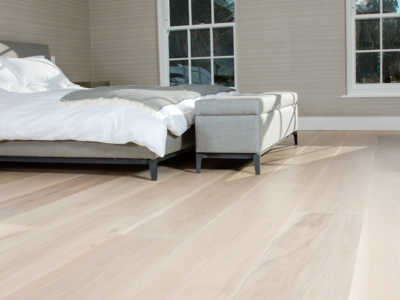
Iga White (white tinted Oak, oil finished, for a contemporary look)
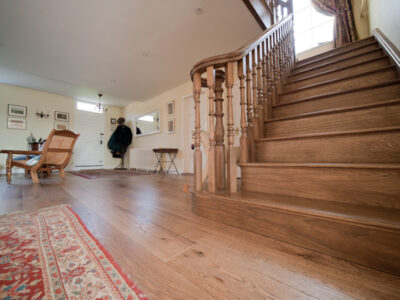
Antiqued Oak (tumbled and coloured for a heritage look)

Iga White (white tinted Oak, oil finished, for a contemporary look)

Antiqued Oak (tumbled and coloured for a heritage look)
I’d love an Oak floor but I’m not sure where to start. How do I choose the perfect wooden floor?
- The first step for any Oak flooring project is to get inspired. Perhaps you have admired friends’ floors, or seen images of beautiful Oak floors in magazines or online.
- Visiting a wood floor showroom, getting professional advice and obtaining real Oak flooring samples will help you decide which flooring will look good and perform well in your home or property.
- We can help you progress your flooring project by arranging a showroom visit, virtual tour or a conversation with one of our experienced advisers who will provide you with product ideas, guidance and tips, as well as answering any questions you may have.
I’d love an Oak floor but I’m not sure where to start. How do I choose the perfect wooden floor?
- The first step for any Oak flooring project is to get inspired. Perhaps you have admired friends’ floors, or seen images of beautiful Oak floors in magazines or online.
- Visiting a wood floor showroom, getting professional advice and obtaining real Oak flooring samples will help you decide which flooring will look good and perform well in your home or property.
- We can help you progress your flooring project by arranging a showroom visit, virtual tour or a conversation with one of our experienced advisers who will provide you with product ideas, guidance and tips, as well as answering any questions you may have.
